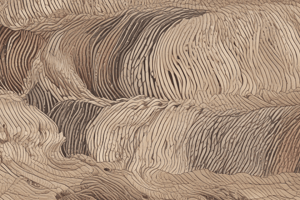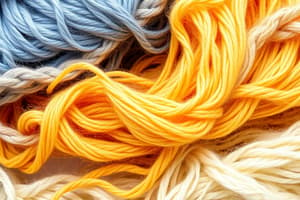Podcast
Questions and Answers
What is a characteristic of natural fibers compared to man-made fibers?
What is a characteristic of natural fibers compared to man-made fibers?
- Natural fibers have a shorter production cycle.
- Natural fibers have a consistent fiber length.
- Natural fibers are produced from synthetic materials.
- Natural fibers can have variable fiber density. (correct)
Which of the following is an example of a regenerated fiber?
Which of the following is an example of a regenerated fiber?
- Nylon
- Acetate (correct)
- Wool
- Asbestos
Which method is used to identify the specific composition of a fiber blend?
Which method is used to identify the specific composition of a fiber blend?
- Qualitative analysis
- Quantitative analysis (correct)
- AATCC 20
- Microscopy
What is a defining factor of man-made fibers in terms of fiber structure?
What is a defining factor of man-made fibers in terms of fiber structure?
Which natural fiber is typically defined by staple or filament?
Which natural fiber is typically defined by staple or filament?
In which aspect do synthetic fibers differ from natural fibers?
In which aspect do synthetic fibers differ from natural fibers?
Which of the following correctly describes the color variation potential of fibers?
Which of the following correctly describes the color variation potential of fibers?
What qualitative method is used to identify a single fiber type?
What qualitative method is used to identify a single fiber type?
What is the primary purpose of the solubility method in fiber identification?
What is the primary purpose of the solubility method in fiber identification?
Which method uses infrared spectral analysis for fiber identification?
Which method uses infrared spectral analysis for fiber identification?
In the context of fiber blends, what does AATCC 20A provide guidance for?
In the context of fiber blends, what does AATCC 20A provide guidance for?
What is the significance of melting point for thermoplastic fibers in fiber identification?
What is the significance of melting point for thermoplastic fibers in fiber identification?
Which of the following is an appropriate method to check the microscopic appearance of fibers?
Which of the following is an appropriate method to check the microscopic appearance of fibers?
What does the burn method primarily assess during fiber identification?
What does the burn method primarily assess during fiber identification?
What is the first step in determining the fiber content using the solubility method?
What is the first step in determining the fiber content using the solubility method?
What should be evaluated when examining the tags of clothing articles for fiber content?
What should be evaluated when examining the tags of clothing articles for fiber content?
Flashcards
Natural Fibers
Natural Fibers
Fibers that are naturally occurring, like cotton, wool, and silk.
Man-Made Fibers
Man-Made Fibers
Fibers created by humans, using chemical processes, like polyester, nylon, and rayon.
Plant Fibers
Plant Fibers
Plant-based fibers, such as cotton, flax, and hemp.
Animal Fibers
Animal Fibers
Signup and view all the flashcards
Regenerated Fibers
Regenerated Fibers
Signup and view all the flashcards
Qualitative Fiber Identification
Qualitative Fiber Identification
Signup and view all the flashcards
Quantitative Fiber Identification
Quantitative Fiber Identification
Signup and view all the flashcards
Microscopy
Microscopy
Signup and view all the flashcards
Burn Method
Burn Method
Signup and view all the flashcards
Staining Method
Staining Method
Signup and view all the flashcards
Solubility Method
Solubility Method
Signup and view all the flashcards
Melt Point Method
Melt Point Method
Signup and view all the flashcards
Solubility Method for Blends
Solubility Method for Blends
Signup and view all the flashcards
FTIR Method
FTIR Method
Signup and view all the flashcards
Microscopic Analysis
Microscopic Analysis
Signup and view all the flashcards
Microscopic Appearance Evaluation
Microscopic Appearance Evaluation
Signup and view all the flashcards
Study Notes
Textile Fibers and Classification
- Textile fibers are categorized into two main types: natural and man-made.
- Natural fibers include:
- Plant fibers (e.g., cotton, flax, hemp, jute, kenaf, ramie, sisal)
- Animal fibers (e.g., wool, silk, alpaca, camel, cow, goat, horse, rabbit, vicuña)
- Mineral fibers (e.g., asbestos)
- Man-made fibers include:
- Synthetic fibers (e.g., polyester, nylon)
- Regenerated fibers (e.g., rayon, acetate, milk fibers)
Detailed Classification of Textile Fibers
- Fibers are further classified into categories based on their origin: animal, vegetable, mineral, and man-made.
- Within each category, there are various subcategories.
Natural vs Man-Made Fibers
- Natural fibers:
- Variable fiber length and diameter
- Fiber structure cannot be changed
- Fibers are typically either staple or filament forms
- Fiber density and crimp are determined by nature
- Limited natural color range
- Production cycles are typically long and unpredictable
- Made from natural polymers
- Man-made fibers:
- Consistent fiber length and diameter
- Fiber structure can be varied
- Can be in filament or staple forms
- Fiber density and crimp can be varied
- Variety of colors available
- Production cycles are typically shorter and more predictable
- Made from polymers
Qualitative vs Quantitative Methods of Identifying Textile Fibers
- Qualitative methods identify the type of fiber present. Examples are microscopy, burn tests, and staining methods.
- Quantitative methods determine the amount of each fiber in a blend. Example: FTIR analysis and solubility methods
How Can a Textile Fiber Be Identified?
- Qualitative methods (AATCC 20) for single fiber type identification include:
- Microscopy: Determine physical shape and match to known images
- Burn test: Evaluate fiber reaction to flame, ash, smell, and smoke
- Staining methods: Identify fiber type by color/shade change
- Solubility method: Determine which solution fiber dissolves in
- Melt point: Thermoplastic fibers melt at different temperatures
Burn Testing Textile Fibers
- Different fibers have distinct reactions to flame, producing unique appearances of ash.
Microscopic Appearance Evaluation of Textile Fibers
- Microscopic examination allows for visual identification of fiber structure and morphology.
- Images provide detailed views of fiber cross-sections and longitudinal views, enabling identification of the type of fabric.
Quantitative Fiber Identification (AATCC 20A)
- Methods like solubility (for simple blends like polyester/cotton), Fourier Transform Infrared (FTIR) spectroscopy, and microscopic analysis for complex blends are used for accurate identification of fibers in a blend.
Solubility Method Example
- Polyester/cotton blend analysis using sulfuric acid dissolves the cellulose (cotton) component, allowing for quantitative measurement of the remaining polyester.
Infrared Spectra of Various Fibers (FTIR)
- FTIR spectroscopy provides unique spectral patterns for different fibers, helping in identifying fiber types.
Melting Point of Textile Fibers
- Different fibers have distinct melting points based on their chemical composition.
Impact of Temperature on Thermoplastic Fibers
- Temperature affects the physical and mechanical properties of thermoplastic fibers.
- Tg, the glass transition temperature, and Tm, the melting point, mark significant changes.
Homework
- Students should examine 10 clothing items to note their fiber compositions.
- Consider common fiber themes in different types of clothing.
- Describe how different fabrics feel and perform.
Studying That Suits You
Use AI to generate personalized quizzes and flashcards to suit your learning preferences.




